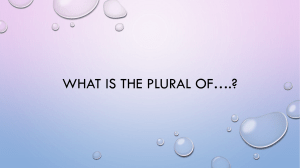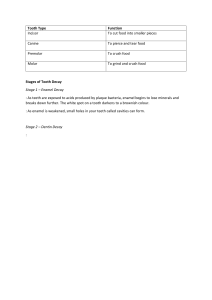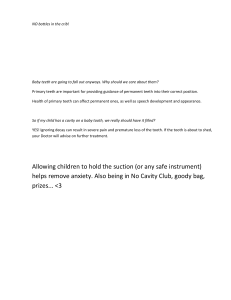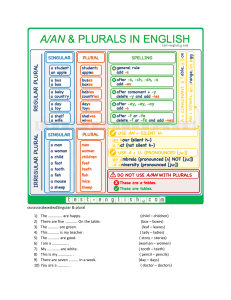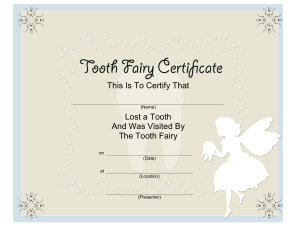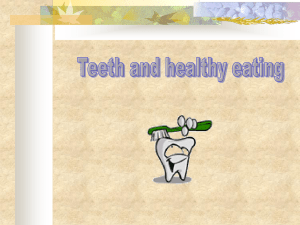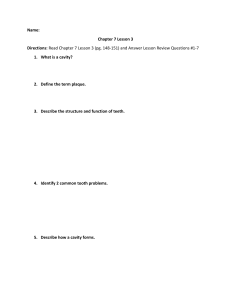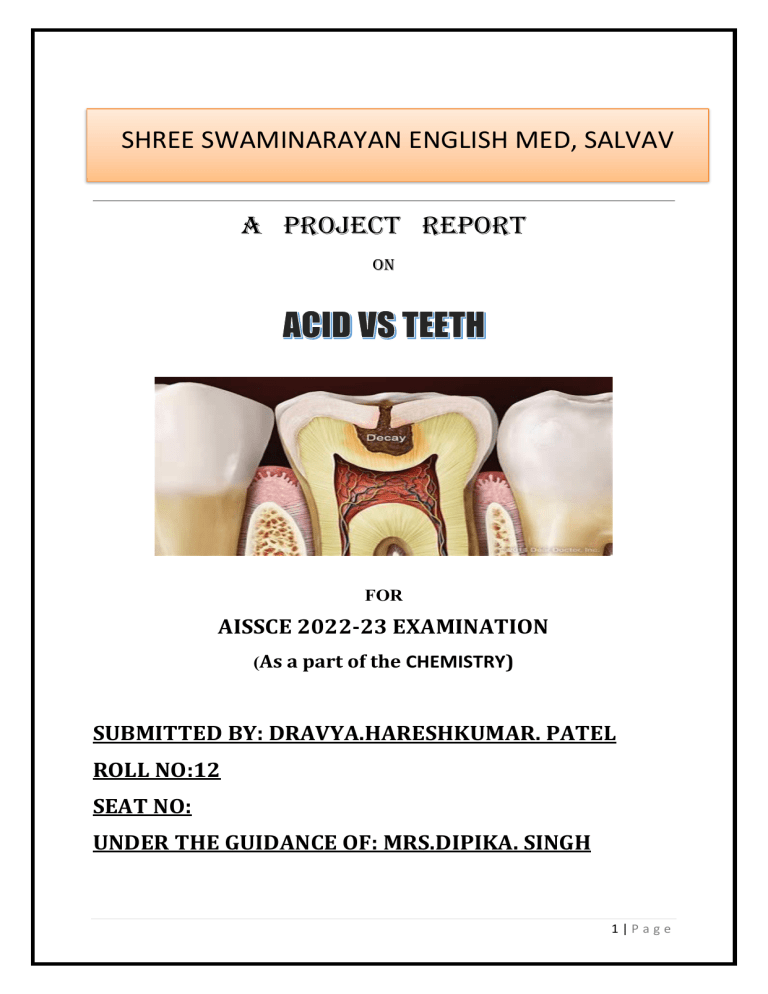
SHREE SWAMINARAYAN ENGLISH MED, SALVAV A PROJECT REPORT ON FOR AISSCE 2022-23 EXAMINATION (As a part of the CHEMISTRY) SUBMITTED BY: DRAVYA.HARESHKUMAR. PATEL ROLL NO:12 SEAT NO: UNDER THE GUIDANCE OF: MRS.DIPIKA. SINGH 1|Page CERTIFICATE This is to certify that the project entitled, ___ACID VS TEETH. is a Bona-fide work done by DRAVYA.HARESHKUMAR. PATEL of class XII-Science From SHREE SWAMINARAYAN GURUKUL, SALVAV For session 2022-23 In partial fulfilment of CBSE’s AISSCE Examination 2022-2023 has been carried out under my direct supervision and guidance. This report or a similar report on this topic has not been submitted for any other examination and does not from a part of any other course undergone by the candidate. SIGN OF EXTERNAL EXAMINER. ________________ SIGN OF INTERNAL EXAMINER ______________ SIGN OF PRINCIPAL _________________________ 2|Page ACKNOWLEDGEMENT I would like to express my deep sense of gratitude to my chemistry teacher MRS.DIPIKA. SINGH for her guidance and support in completing my project. A special thanks to our principal mam MRS.MINAL. DESAI for giving me the opportunity to do this project. This project helped me in doing a lot of research and I came to know about so many new things. I am grateful to my parents who gave valuable suggestion and guidance for the completion of my project. They helped me finalising project in the limited time frame. 3|Page 1. Acknowledgement 2. Introduction 3. What is tooth erosion? 4. How is tooth erosion caused? 5. How to prevent tooth erosion? 6. pH and tooth decay 7. Experiment 4|Page You might want to think twice before taking another sip of soda. Although our teeth are incredibly strong, popular acidic drinks can damage our teeth over time. Acidic drinks eat away at your tooth enamel, the outer layer of your teeth. This erosion puts your smile at risk of cavities — because the enamel doesn’t grow back! Unfortunately, unlike other parts of our bodies, teeth have no way of healing themselves. As the enamel erodes, you may experience tooth sensitivity, be prone to cavities and even experience some discoloration. Erosion is different from tooth decay and is not caused by sugar; instead, acids from foods and drinks (sometimes stomach acid) soften the tooth directly. If this happens often, the teeth may gradually wear away. Acid plays a huge role in wearing away the enamel of your teeth and the food and drink that you consume determines how much acid your teeth are exposed to on a daily basis. Anyone suffering from a health condition, such as acid reflux or bulimia, may also see increased tooth erosion as the teeth are also damaged by exposure to stomach acids. 5|Page Erosion is the wearing away of the tooth surface by an acid, which dissolves the enamel and the dentine. There are a variety of ways that tooth structure is lost. Food-based dental erosion was first described in 1892 among Sicilian lemon pickers. Food and beverages can dissolve tooth structure if they are acidic enough. Gastric regurgitation is another source of acid that can dissolve teeth. Exposure to environmental substances in the air might also be a source of the erosive chemical. While rare, some individuals have saliva that is acidic enough to dissolve exposed dentin surface, and when it is impossible to find the source, this is called idiopathic erosion. At its most basic tooth erosion is where the structure of the tooth is damaged because the dental enamel has been weakened. Enamel is a protective layer of hard tissue that helps your teeth maintain their structure and when this is worn away it exposes the core tissue of the tooth (the ‘dentin’) underneath, which makes teeth look discoloured. The acid produced in the stomach during the digestive process is sufficiently powerful to dissolve any food, including bone and teeth. When the contents of the stomach are regurgitated, the acid comes into contact with the teeth. Any condition that causes repetitive vomiting or regurgitation will cause erosion of teeth. 6|Page People with diseases such as gastroesophageal reflux disease (GERD)1, anorexia nervosa, and eating disorders like bulimia suffer from tooth erosion. GERD is quite common, and an average of 7% of adults experience reflux daily. The leading cause of GERD is increased acid production by the stomach. 7|Page Acid plays a huge role in wearing away the enamel of your teeth and the food and drink that you consume determines how much acid your teeth are exposed to on a daily basis. Anyone suffering from a health condition, such as acid reflux or bulimia, may also see increased tooth erosion as the teeth are also damaged by exposure to stomach acids. All food and drink contains a percentage of acid but some are particularly bad, for example: all soft drinks (including low sugar and diet), carbonated drinks, wine, fruit juice, coffee, cocoa, fruit, honey, yoghurt and pickles in vinegar. 8|Page There are some very easy steps that you can take to reduce the impact that food and drink has on your teeth when it comes to acid erosion. Perhaps the most obvious is to stop consuming carbonated drinks and opt for water instead. If you do still drink carbonated drinks, use a straw so that the liquid has less chance of touching your teeth. In general, don’t keep acidic foods in your mouth for longer than is necessary to chew them – swallow them quickly (although you must make sure they are chewed enough to digest first). When you know you’ve just consumed high acid food or drink, use water to neutralise the acids in your mouth or try some sugar free gum, as this will encourage your mouth to produce more saliva and remineralise your teeth. Try only eating acidic foods during meals, rather than as snacks, so that you don’t constantly have acid attacking your teeth throughout the day, and opt for a soft tooth brush and a toothpaste with fluoride. 9|Page Exactly What Is pH? To put it simply, pH is a measure of acidity… The lower the pH, the higher the acidity, and the higher the pH, the higher the alkaline levels, or basicity. The pH scale runs from 1 to 14, and in the middle of the scale is the neutral number 7, being most like water. This is where we want our mouths to be. While we know that sugar feeds the bacteria that produces acids and turns into cavities, it is actually prolonged acidic oral pH that can cause tooth decay and a demineralization of your enamel. 10 | P a g e 11 | P a g e EXPERIMENT Abstract Acid is a highly corrosive substance that is in all batteries, many chemicals, and industrial wastes. Surprisingly, it is also on many people's teeth! According to the Merck Manual of Medical Information, carbohydrates and sugars are the biggest culprits of tooth decay. It states that "all simple sugars including table sugar (sucrose) and sugars in honey (levulose and dextrose), fruit (fructose), and milk (lactose) have the same effect on the teeth. Whenever sugar comes in contact with plaque, streptococcus mutans bacteria in the plaque produce acid." Interestingly, the bacteria and the sugar do not directly cause the tooth decay. It is really the acid, the by-product resulting from the bacteria consuming the sugars, that causes tooth decay. Acid demineralizes or dissolves teeth and cause tooth decay. Thus, a tooth with decay should weigh less than a tooth without decay 12 | P a g e Methods/Materials 1.The process of this experiment is as follows. 80 teeth were gathered and cleaned of all stains, plaque, and debris by special tools such as hand scalers, EMS (electro-magnetic scalers), and polishers. 2.The teeth were blotted dry with lint-free Kim-Wipes tissue and weighed on a Sartorius scale to 0.0001 gram. 3.They were then placed in 10 individual vials in 8 categories and labelled from control (pH7), pH2, pH3, pH4, pH5, pH6, Neutral Sodium Fluoride, and Acidulated Phosphate Fluoride. 4.The teeth were allowed to decay for about 2 months before reweighing them on the same Sartorius scale in the exact same manner. 13 | P a g e Results According to Dentistry Today (November 2005), "acid pH levels cause tooth surfaces to lose calcium and phosphorous ions" which leads to decay. Acid is able to start to damage teeth once the pH drops below a 5. Acid essentially chelates and dissolves the teeth. The teeth in solutions with pH4, pH5, and pH6 had very little change. But, when the pH level dropped below pH4, the demineralization process occurred at a much faster rate. In fact, there is a 4-fold difference between pH2 and pH6. Our study shows that there is a dramatic increase in demineralization at pH under 4. 14 | P a g e Conclusions/Discussion From my results I came to the conclusion that my hypothesis was correct. The larger solutes exerted more osmotic pressure on the water than the smaller solutes. By researching my project's topic, I was able to apply it to the function of the kidneys in the human body. The nephron in the kidney is where membrane transport to maintain the body fluids and blood concentration occurs. One form of membrane transport is osmosis and diffusion. This project was to observe acid does affect the decay of teeth. The more acid there is in the solution, the greater is the amount of decay. The greatest destruction occurs when the pH level drops below 4. Fluoride definitely helps in reversing or minimizing the damaging effect of tooth decay! 15 | P a g e • https://fairfielddentalarts.com/how-does-acid-affect-your-teeth/ • https://www.smilepad.co.uk/2014/09/09/how-does-acid-affect-yourteeth/ • https://www.orthodonticslimited.com/teeth/ph-levels-tooth-decay/ • https://www.slideshare.net/chiseldental/this-is-how-acid-affects-yourteeth https://ostrowon.usc.edu/tooth-erosion/ 16 | P a g e
